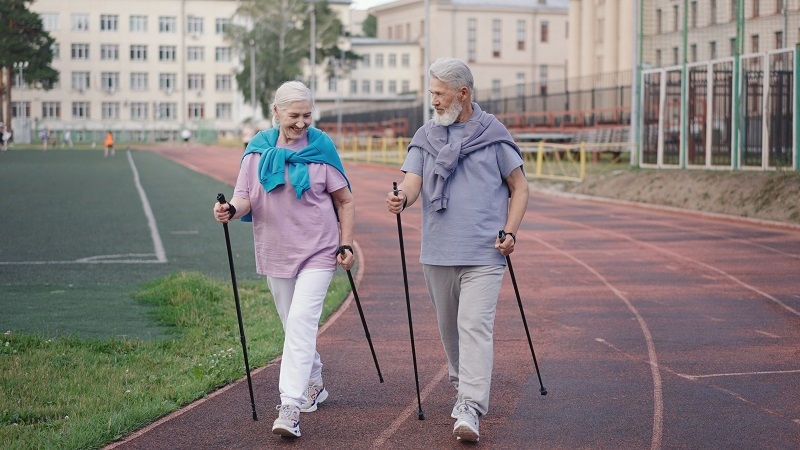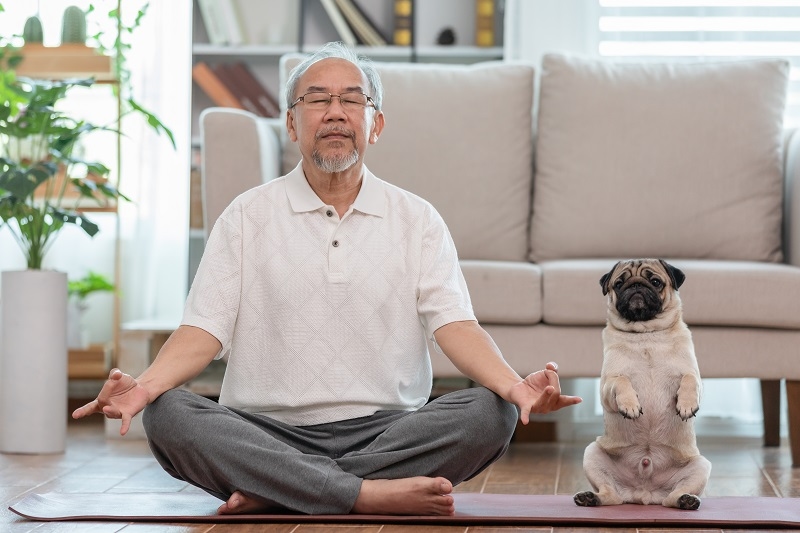Boost Safe Exercise Routines for Senior Health with Credence

As humans age, staying active will become crucial for retaining independence, stopping injuries, and improving overall well-being. Adopting stable workout sporting events not only strengthens the frame but also promotes intellectual fitness, balance, and long-term energy. For seniors, these exercises are particularly precious in enhancing senior fitness, ensuring the safety of affected individuals, and providing continual support as needed. Guided secure motion, combined with ordinary manner of existence habits, can drastically contribute to healthful growing older and permit older adults to keep gambling existence with confidence. This blog affords an in-depth guide on realistic steps, protection measures, and sports activities tailored to seniors.
Why Safe Exercise Routines Matter for Healthy Aging?
When discussing sturdiness, the amazingness of existence is just as important as years lived. Safe and set up sports play a pivotal role in keeping seniors unbiased.
Physical Benefits of Safe Exercise Routines
- Strengthens bones and muscle tissues, lowering the chance of osteoporosis.
- Improves cardiovascular health for typical stamina.
- Enhances flexibility and balance to lower fall dangers.
Mental and Emotional Benefits
- Exercise boosts mood through releasing endorphins.
- Supports cognitive function and reminiscence retention.
- Encourages social interaction via organization commands, selling emotional well-being.
Connection to Healthy Aging
Safe workout exercises contribute directly to wholesome aging by preventing age-related decline. They assist seniors in holding electricity, staying connected, and maintaining independence, even as decreasing clinic visits are linked to a state of no hobbies or falls.
Tips for Safe Initiation of Senior Fitness
It is important to remember that beginning any training program later in life involves special considerations. Senior fitness means tailoring any program to the person's desires, situation, and dreams.
Consultation
- Always seek medical clearance before beginning a new training program.
- Be sure to discuss ongoing health conditions with any health-care vendor prior to.
- Review current medications and their effects on exercise tolerance prior to.
Start Slow & Build Gradually
- Begin with low-impact recreational activities like walking or swimming.
- Build intensity slowly, minimize stress to joints.
- Celebrate small development milestones to encourage consistency.
Choose the Right Activities
- Strength training with moderate weights or resistance bands.
- Chair yoga for flexibility and stability.
- Water aerobics for joint-friendly motion.
Patient Safety and Exercise Precautions
Ensuring men's or women's safety should be the top priority while encouraging seniors to undertake fitness activities.
Essential Safety Cautions
- Ensure the footwear you wear is supportive to prevent slips or falls.
- Warm up and work down to the guard muscle mass and joints.
- Hydrate before you start, while you are active, and after activity.
Recognizing Warning Signs
- Discontinue exercise if you feel dizzy, experience chest pain, or feel short of breath.
- Be self-aware of unusual fatigue or discomfort beyond normal "pain."
- If symptoms continue, seek medical advice right away.
Preparing a Safe Environment
- Clear the exercise area of clutter and/or tripping hazards.
- Use assistive devices (for example, grab bars, stable chairs, lettuce or grip shoes, etc.).
- Ensure good light when indoors and exercising.
Chronic Illness Support Through Exercise
Many seniors stay with ongoing health situations, but stable exercise sports can provide powerful, persistent infection help while being controlled.
Benefits for Chronic Conditions
- Arthritis: Gentle stretching can help decrease stiffness.
- Diabetes: Engaging in a regular hobby can change blood sugar levels.
- Heart disease: Regular aerobic exercise increases cardiovascular capacity.
Personalized Exercise Programs
- Work with a rehabilitation facility, physical therapist, or running shoes specializing in elderly care.
- Modify sports based on the individual level of fitness and health.
- Balance rest with a sport to prevent overdoing it.
Incorporating Physical Activity into a Care Plan
- Plan to incorporate gentle active walking every day into your routine.
- Use exercise as an adjunct for medical treatment.
- Ensure accountability with healthcare providers to track improvements- for motivation and safety.
Creating Lifestyle Changes Around Exercise
Physical activity is not only about the activity itself but also about developing a routine for long-term overall health.
Consistency Is Important
- Establish a routine of physical activity, for example, morning walks or evening stretches.
- Encourage duty with organization education or strolling partners.
- Keep lessons short but regular to shape sturdy conduct.
Balanced Nutrition
- Pair workout with a senior-friendly, balanced weight loss program.
- Focus on calcium, food plan D, and lean proteins to assist muscle and bone fitness.
- Stay hydrated to enhance energy and prevent dizziness.
Rest and Recovery
- Allow the body time to get better among sports activities.
- Prioritize sleep for muscle restoration and overall well-being.
- Practice slight stretches or meditation for relaxation.

Safe Exercise Routines Seniors Can Try
Here are examples of smooth, powerful, and occasional-impact workout routines that sell senior fitness and enhance wholesome aging.
Strength Building Workouts
- Wall push-U.S. for upper body strength.
- Light resistance band pulls to improve posture.
- Chair squats for muscle strength in the legs.
Flexibility and Balance
- Gentle yoga postures (such as seated twists).
- Tai chi movements for balance and coordination.
- Heel-to-toe walking lessens the risk of falling.
Cardio
- Brisk walking, for resistance, at least 20 minutes a day.
- Stationary cycle, low stage.
- Low-environment dancing for movement and fun for amusement.
Healthy Aging with Social Fitness Programs
The social interaction of people and the movement of group health exercise is beneficial for mood and body.
Benefits of Group Classes
- Creates accountability for attendance and continuation of activity.
- Reduces isolation, which is not an unusual problem among seniors.
- Provides guided supervision for the protection of the affected person.
Types of Group Programs
- Senior-centered yoga or Pilates.
- Water aerobics in community swimming pools.
- Dance or movement remedy instructions for a laugh exercise.
How Social Engagement Boosts Lifestyle Habits
- Builds self-assurance in keeping secure exercises.
- Provides an aid system for seniors facing persistent contamination-demanding situations.
- Reinforces fitness cognizance and emotional resilience.
Technology to Support Safe Exercise Routines
Modern tools can make stable exercising sporting events more powerful and trackable for seniors.
Wearable Devices
- Smartwatches track steps, heart rate, and sleep.
- They will send alerts if there are heart rhythm changes or if the user is inactive.
Online Classes
- Seniors can follow guided health programs in the center.
- Offering different workout modalities to keep seniors active.
Mobile Apps
- Reminders to engage the elderly in daily activity goals.
- Logs to share progress in settings with health care providers.
Addressing Barriers to Senior Fitness
While the benefits are clear, many adults are reluctant to utilize exercise because of physical, cognitive, or environmental barriers.
Common Barriers
- Fear of injury or falls.
- Motivational or self-perception barriers.
- Chronic illness prescribing bodily capability.
Practical Solutions
- Start with chair-based or water-supported bodily games.
- Establish realistic aspirations to help minimize frustration.
- Utilize family and caregiver support as accountability.
Designing a Lifetime Fitness Plan for Our Seniors
Life-long fitness routines have such valuable health benefits for aging well and health.
- Step 1: Evaluation
- Evaluate the scientific evidence and exercise levels.
- Skin is a risk factor for chronic disease.
- Step 2: Design
- Match aerobic, strength, and flexibility.
- Adapt as personal goals and abilities change.
- Step 3: Monitor & Modify
- The nurse checks in on the progress made with the healthcare provider.
- Modifying intensity based on in-the-moment physical changes
Be flexible (meaning don't stifle workouts) while maintaining long-term exercise.
Caregiver Responsibilities with Fitness Teaching
Caregivers are vital in ensuring patient safety and chronic disease management in seniors participating in health programs.
Encouragement & Motivation
- Provide reminders and support in creating routines.
- Acknowledge and celebrate progress to build self-efficacy.
- Encourage participation in a social program.
Safety
- Supervise physical activities that pose a risk to balance.
- Keep emergency contact information accessible and visible.
- Ensure the type of space is safe and accessible to the seniors' care facility.
Conclusion
Adopting secure workout physical games is a powerful way for seniors with persistent fitness conditions to improve mobility, energy, and overall well-being. By specializing in low-impact sports activities, proper warm-ups, and guided assistance, seniors can reduce the risk of injury while building self-awareness of their health. Safe exercise workouts enhance physical health and sell highbrow resilience, independence, and a higher quality of life. With steady exercise, medical guidance, and encouragement from caregivers, seniors can include exercising with credence, making sure a greater match, extra steady, and more lively lifestyle properly into their golden years.
This content was created by AI

